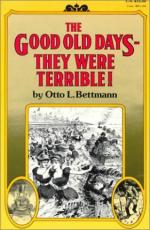
|
| Name: _________________________ | Period: ___________________ |
This test consists of 5 multiple choice questions, 5 short answer questions, and 10 short essay questions.
Multiple Choice Questions
1. Which part of the population got to enjoy the luxuries of ocean liners in the late 19th century?
(a) Politicians.
(b) Foreign dignitaries.
(c) The rich.
(d) Immigrants.
2. What was the General Slocum?
(a) A ferry that had the best safety record on the Hudson River.
(b) A ferry that blew up and killed 1000 passengers.
(c) A ferry that sank due to overcrowding.
(d) A ferry that collided with a barge, killing hundreds.
3. According to Bettmann in "Travel," what was often the result of an open-window train car?
(a) Occupants would choke on smoke from the engine.
(b) Passengers were crime victims at railway stations.
(c) Passengers suffered from insect bites.
(d) Passengers would freeze.
4. How did the teachers in the late 1800s fight the lack of discipline with the students?
(a) They segregated their classes by age.
(b) Corporal punishment.
(c) Lots of field trips.
(d) They refused to teach without help.
5. How were the prostitution laws enforced in New York City in the late 19th century?
(a) They were only enforced in certain areas of the city.
(b) Only loosely.
(c) They were ignored entirely.
(d) Regularly and vigorously.
Short Answer Questions
1. Disease and sickness on the ocean liners caused them to be nicknamed:
2. In the late 1800s, what disease affected the city dwellers as well as the frontier people?
3. How were the boilers a danger to the ferries according to Bettmann in "Travel"?
4. What was a chief concern with train travel in the late 1800s?
5. What was "bogus butter"?
Short Essay Questions
1. How did the lack of medical advances affect the population of the post Civil War era?
2. Why were the some ocean liners nicknamed "fever ships" and "floating coffins"?
3. After the Civil War, how effective were the hospitals at helping the sick and infirm?
4. What was "bogus butter"?
5. In the late 19th century, how did the lack of a meat-packing industry affect the quality of meat that was available to the general public?
6. In the late 19th century, how did ocean liner travel exemplify the differences in travel for the rich and travel for the poor?
7. How was drug addiction so rampant in the average population in the late 1800s?
8. How did alcohol affect families on the frontier?
9. According to Bettmann in "Travel," how were the below-deck boilers a danger to ferry travelers?
10. What type of education did blacks receive during the post Civil War era?
|
This section contains 776 words (approx. 3 pages at 300 words per page) |

|




